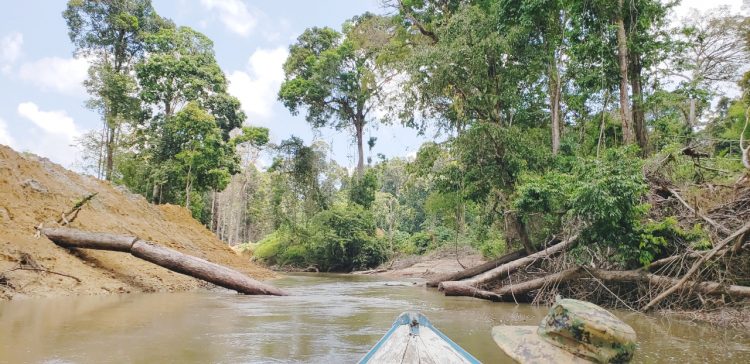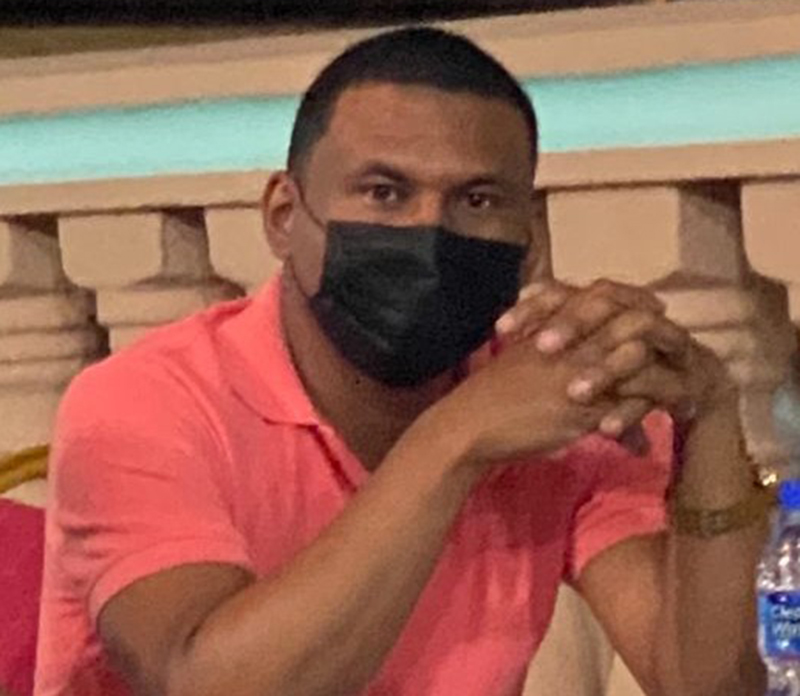With the government committing itself to responding to the recommendations of the Inter-American Commission on Human Rights (IACHR) report on the violation of the rights of Isseneru villagers, the community has noticed increased activities by the Guyana Geology and Mines Commission (GGMC) to address their concerns.
During a recent interview with Sunday Stabroek, Secretary of the Isseneru Village Council Igor Semple related that since the decision of the IACHR, they have been approached by GGMC officers in a bid to find out the issues as well as other information relating to mining operations within the community.

Isseneru, an indigenous community consisting largely of people from the Akawaio nation, and the Amerindian Peoples Association (APA) approached the IACHR on September 5, 2013, arguing that the government had violated the rights of the community and its members to property, equality before the law, justice and a fair trial, to the protection of mothers and children, to the preservation of health and wellbeing, and to enjoy the benefits of culture. All of these rights were protected by several Articles of the America Declaration on the Rights and Duties of Man.
The appeal to the IACHR partly stemmed from two High Court rulings against the village’s objections to mining projects. Back in 2013, Justice Diana Insanally made orders granted to miner Joan Chang against the Isseneru Village Council and the Guyana Geology and Mines Commission (GGMC) binding. Members of the Village Council had claimed that the mining company was mining on titled lands without the council’s permission under the Amerindian Act and despite subsequent Cease Work Orders (CWOs) issued by the GGMC mining officer. Justice Insanally pointed out in her ruling that by virtue of Chang being granted a licence to mine prior to the coming into operation of the Amerindian Act of 2006, the Village Council had no authority to stop the operation and the GGMC no authority to issue the CWOs.
On August 13, 2008, a similar judgment was made in the High Court in the case of Lalta Naraine v Isseneru. The case of Naraine has been appealed and is languishing at the Court of Appeal since 2008/2009 according to the villagers.
Following the report of the IACHR, the Village Council travelled to Georgetown where it held a press conference revealing that 25% of the Isseneru’s titled lands are being mined by Naraine and that there are over 100 mining concessions within the village’s titled and ancestral lands.
The village said that the damage caused by unapproved mining has resulted in intensified destruction of not only the environment but also the way of life.
Semple told Sunday Stabroek that when the Council returned to the village, following their press conference, GGMC officers met with them to discuss the issues.
“We had a visit from GGMC and they came to find out what our issues were and if we are having any [issues] and they also wanted from us all the names of the dredge owners and that sort of information. Officially, from the government, we have not heard anything but through GGMC we noticed that they are taking a bit more interest in our mining affairs,” he explained.
He related that a list of approved dredge owners was presented to the GGMC and the officers have been working to crackdown on those unapproved operations.
“We are sceptical [of GGMC] because whenever it has to do with petitions the government always sends these GGMC officers sometimes to close us down and so. We didn’t have a good relationship with the government in the past so the village is just as apprehensive at the moment because they want to know what will the government do next whether it be a good thing or so. They are on the lookout, everyone is on the lookout to see the next step,” he added.
Semple reported that the village has also observed increased movement of miners out of the Naraine concession – a move that they welcomed.
“…there are a lot of miners coming out of the concession. Most of them saying that they feel the government will give back the village the land, so presently we notice a movement out of the concession and also GGMC is doing a lot more work in trying to clamp down on the illegal shops in Narine concession. We noticed the increase in movement from the GGMC,” he said.
The report said the state violated “…the right to indigenous collective territorial property of the Isseneru community and its members because the mining operations developed by Messrs. Lalta Naraine and Joan Chang were not the subject of prior consultations, socio-environmental impact assessments, or reasonable benefit-sharing mechanisms before they began implementation.
“The right to collective territorial property, and its interconnected rights to health, food, water, a healthy environment and cultural integrity, because in relation to the untitled lands -within Isseneru’s ancestral territory the State has granted mining permits which have not been consulted, assessed in their environmental and social impacts, nor been the matter of reasonable benefit sharing.”
The IACHR highlighted that, if any permits, concessions or licenses are issued for mining, forestry or any other extractive activity within the untitled parts of Isseneru’s ancestral territory before said territory is duly titled, demarcated and delimited in its full extent, the State of Guyana would incur in a violation of international law, in particular of the right to collective property under Article XXIII of the American Declaration.
…possible way forward
IACHR, in its December 2021 report, informed both parties that the state is responsible for at least 16 violations of the rights of the Isseneru community and its members. Among others, the IACHR identified that the Amerindian Act of 2006 failed to recognize the pre-existence of indigenous territorial rights, and did not obligate the state to grant indigenous communities title to ancestral territory.
The IACHR report informed that the state failed to grant Isseneru title over its entire ancestral territory despite the community demonstrating that it is a primarily Akawaio village, that it is set within Akawaio territory and, among others, it needs the full extent of the territory to pursue livelihood and survival. Additionally, it further concluded that the community’s rights to health, water, food and a healthy environment were violated by the negative impacts of mining in the community particularly contamination of waterways.
The IACHR recommended that the government employ the necessary measures to support Isseneru and its members in their duty to preserve and protect the environment, particularly in relation to the mining operations that the community undertake on its ancestral lands.
Semple related that the Village Council convened a meeting with villagers where it went through, in-depth, the merits of the petition as well as the recommendations of the IACHR.
“Generally they welcome the decision. They would like the government to respect the decision, they would like the government to respect the decision. Some of them did have some concerns because they too are a bit uncomfortable not knowing what the government want to do. They asked us questions like what we think the government will do or want to do and we told them we don’t know what the next step of the government will be,” he said.
He added that they had the lawyers that presented the petition to the IACHR visit the community and spent two days exploring a possible way forward as well as addressing questions from the villagers. He said that the dominating questions revolved around whether the village would get its titled land back and how is it going to deal with the damage caused by mining.
“It was the general view that the land that we requested, 90% of them are already destroyed through mining and that was one of their concerns. They would like to see the government take positive steps to correct their mistakes. They want all the land back but we know that 90% of our original land is already destroyed. They are just waiting to see what the government will do [whether] will they give us back the land so that we can decide what we want to do with the damaged land because there really is not much you can do with damaged land,” he related.
Semple said that during the meeting the villagers decided that a final meeting will be held this week with the intention of coming up with a final plan on the way forward.
…reparations and deadlines
IACHR has given the government two months to “comply with the Commission’s recommendations and resolve the situation.” IACHR’s recommendations included, among other things, that the necessary measures be adopted to ensure that the village and its members receive “full reparations for the material and immaterial damages they suffered on the account of the violation of their human rights.”
Additionally, the IACHR advised government to “…amend its legislation in order to secure that the provisions of the relevant Acts and regulations related to indigenous territorial property are in harmony with the American Declaration, in accordance with international law according to the present merits report.”
Semple told Sunday Stabroek that there are varying views on the issue of reparations by the villagers and that the Council and lawyers are exploring all. He said that one of the major concerns is how they would attach a monetary value to the loss of traditional lands, way of life and other aspects that were destroyed during the years of violation.
“When it comes to compensations for the damage there are questions that we put forward for further definition from the lawyer and clarification from specialists because there are some specialists that can price forests and we don’t have that expertise in the village. We told them [lawyers] that we knew where we used to go to get materials to make our baskets, sifters etc and our farms and all of the lands have been damaged but we never used that as a market to sell so we don’t have a price point to say [that this is what we made by selling those things].
“Our fish, we never used to sell fish so even the lands that are destroyed where our fish was we can’t put a price to it. So that is kind of the conversation we had during our public meeting. It was more like bringing out what we think should happen and seek further clarification on it,” he explained.
IACHR has given the government until June 20, 2022, to submit its response and Prime Minister Mark Phillips has already committed to doing so.
“I wish to assure (the CPA) that the parliamentarians that form the government …are committed to the respect for the rule of law domestically and internationally…I wish to assure you that with regards to the Isseneru issue, we have unlike what was represented until June 20th to respond to the recommendations of the Inter American Commission for Human Rights,” the Prime Minister said during his address to the Commonwealth Parliamentary Association (CPA) seminar for Guyanese Members of Parliament held last month.
Minister of Amerindian Affairs Pauline Sukhai had told Sunday Stabroek that the Ministry of Parliamentary Affairs and Governance will be responsible for the response to IACHR. Several attempts to contact Minister Gail Teixeira have proven unsuccessful.






